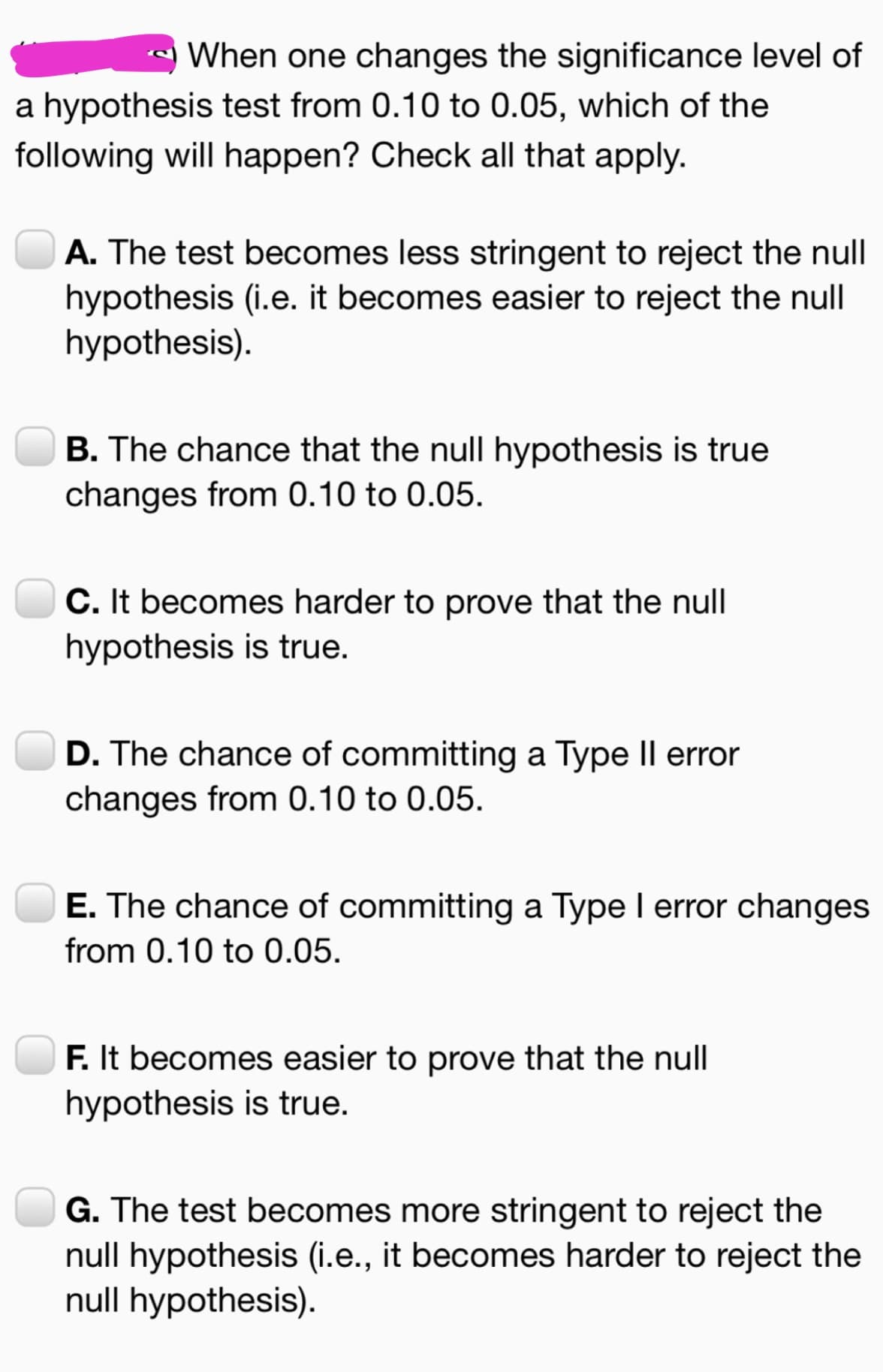When one changes the significance level of a hypothesis test from 0.10 to 0.05, which of the following will happen? Check all that apply. A. The test becomes less stringent to reject the null hypothesis (i.e. it becomes easier to reject the null hypothesis). B. The chance that the null hypothesis is true changes from 0.10 to 0.05. C. It becomes harder to prove that the null hypothesis is true. D. The chance of committing a Type II error changes from 0.10 to 0.05. E. The chance of committing a Type I error changes from 0.10 to 0.05. F. It becomes easier to prove that the null hypothesis is true. G. The test becomes more stringent to reject the null hypothesis (i.e., it becomes harder to reject the null hypothesis).
When one changes the significance level of a hypothesis test from 0.10 to 0.05, which of the following will happen? Check all that apply. A. The test becomes less stringent to reject the null hypothesis (i.e. it becomes easier to reject the null hypothesis). B. The chance that the null hypothesis is true changes from 0.10 to 0.05. C. It becomes harder to prove that the null hypothesis is true. D. The chance of committing a Type II error changes from 0.10 to 0.05. E. The chance of committing a Type I error changes from 0.10 to 0.05. F. It becomes easier to prove that the null hypothesis is true. G. The test becomes more stringent to reject the null hypothesis (i.e., it becomes harder to reject the null hypothesis).
College Algebra (MindTap Course List)
12th Edition
ISBN:9781305652231
Author:R. David Gustafson, Jeff Hughes
Publisher:R. David Gustafson, Jeff Hughes
Chapter8: Sequences, Series, And Probability
Section8.7: Probability
Problem 58E: What is meant by the sample space of an experiment?
Related questions
Question

Transcribed Image Text:When one changes the significance level of
a hypothesis test from 0.10 to 0.05, which of the
following will happen? Check all that apply.
A. The test becomes less stringent to reject the null
hypothesis (i.e. it becomes easier to reject the null
hypothesis).
B. The chance that the null hypothesis is true
changes from 0.10 to 0.05.
C. It becomes harder to prove that the null
hypothesis is true.
D. The chance of committing a Type II error
changes from 0.10 to 0.05.
E. The chance of committing a Type I error changes
from 0.10 to 0.05.
F. It becomes easier to prove that the null
hypothesis is true.
G. The test becomes more stringent to reject the
null hypothesis (i.e., it becomes harder to reject the
null hypothesis).
Expert Solution
This question has been solved!
Explore an expertly crafted, step-by-step solution for a thorough understanding of key concepts.
This is a popular solution!
Trending now
This is a popular solution!
Step by step
Solved in 2 steps

Recommended textbooks for you

College Algebra (MindTap Course List)
Algebra
ISBN:
9781305652231
Author:
R. David Gustafson, Jeff Hughes
Publisher:
Cengage Learning

College Algebra (MindTap Course List)
Algebra
ISBN:
9781305652231
Author:
R. David Gustafson, Jeff Hughes
Publisher:
Cengage Learning